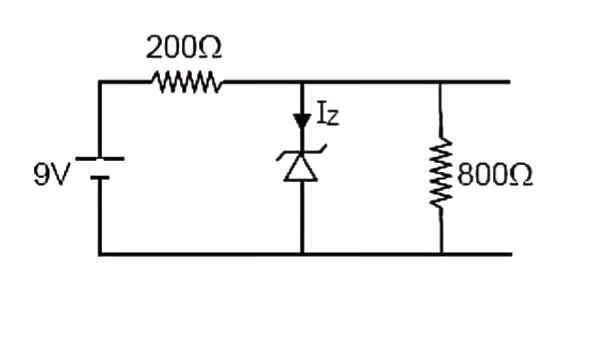In a p-n junction diode, the current I can be expressed as
I=I0[exp(eVKBT)−1]
where I0 is called the reverse saturation current, V is voltage across the diode and is positive for forward bias and negative for reverse bias and I is current through the diode, KB is Boltzmann constant (8.6×10−5eVK−1) and T is the absolute temperature. If for a given diode I0=5×10−12A and T = 300 K, then
What will be the change in current if reverse bias voltage changes from 1 V to 2 V?
The current I through a junction diode is given as
I=I0[exp(eVKBT)−1]
where I0=5×10−12A,T=300K,kB=8.6×10−5eVK−1=8.6×10−5×1.6×10−19JK−1
For both the voltages, the current I will be almost equal to I0, showing almost infinite dynamic resistance in the reeverse bias.
Similar Questions
In a p−n junction diode, the currect I can expressed as I=I0exp(eV2kBT−1) where I0 is called the reverse saturation current, V is the voltage across the diode and is positive for forward bias and negative for reverse bias, and I is the current through the diode, KB is the Boltzmann constant (8.6×10−5eV/K) and T is the absolute temperature. If for a given diode Io=5×10−12A and T=300K, then
(a) What will be the forward current at a formward voltage of 0.6V ?
(b) What will be the increase in the current if the voltage across the diode is increased to 0.7V ?
( c) What is the dynamic resistance ?
(d) What will be current if reverse bias voltage changes from 1V to 2V ?
View SolutionIn a p−n junction diode, the currect I can expressed as I=I0exp(eV2kBT−1) where I0 is called the reverse saturation current, V is the voltage across the diode and is positive for forward bias and negative for reverse bias, and I is the current through the diode, KB is the Boltzmann constant (8.6×10−5eV/K) and T is the absolute temperature. If for a given diode Io=5×10−12A and T=300K, then
(a) What will be the forward current at a formward voltage of 0.6V ?
(b) What will be the increase in the current if the voltage across the diode is increased to 0.7V ?
( c) What is the dynamic resistance ?
(d) What will be current if reverse bias voltage changes from 1V to 2V ?
View Solution
Knowledge Check
Passage II
Diode current in a p-n junction diode is given by I−I0[exp(eV)2kT−1] where I0 is the reverse saturation current V is the voltage across the diode k is the boltzmann constant and T is the abosolute temperatuer For a given diode I0=5 pA and T =300 k
When the reverse bias voltage bias voltage changes from 1 v to 2 V the current will become equal toA2I0BI0C−I0D−2I0Passage II
Diode current in a p-n junction diode is given by I−I0[exp(eV)2kT−1] where I0 is the reverse saturation current V is the voltage across the diode k is the boltzmann constant and T is the abosolute temperatuer For a given diode I0=5 pA and T =300 k
The forward current at a foward voltage V=0.6 V isA0.05475 AB0.06319 AC0.04482 AD0.03798 A
In a p−n junction diode, the currect I can expressed as I=I0exp(eV2kBT−1) where I0 is called the reverse saturation current, V is the voltage across the diode and is positive for forward bias and negative for reverse bias, and I is the current through the diode, KB is the Boltzmann constant (8.6×10−5eV/K) and T is the absolute temperature. If for a given diode Io=5×10−12A and T=300K, then
(a) What will be the forward current at a formward voltage of 0.6V ?
(b) What will be the increase in the current if the voltage across the diode is increased to 0.7V ?
( c) What is the dynamic resistance ?
(d) What will be current if reverse bias voltage changes from 1V to 2V ?
View SolutionIn a p−n junction diode, the currect I can expressed as I=I0exp(eV2kBT−1) where I0 is called the reverse saturation current, V is the voltage across the diode and is positive for forward bias and negative for reverse bias, and I is the current through the diode, KB is the Boltzmann constant (8.6×10−5eV/K) and T is the absolute temperature. If for a given diode Io=5×10−12A and T=300K, then
(a) What will be the forward current at a formward voltage of 0.6V ?
(b) What will be the increase in the current if the voltage across the diode is increased to 0.7V ?
( c) What is the dynamic resistance ?
(d) What will be current if reverse bias voltage changes from 1V to 2V ?
View SolutionIs reverse saturation current of a diode independent of reverse bias voltage?
View SolutionDraw the V-I characterisitics of p-n junction diode in forward bias and in reverse bias.
View SolutionDraw the graph showing the variation of current with voltage for a p-n junction diode in forward bias as well as revese bias arrangements.
View SolutionIn the figure, the reverse breakdown voltage of a Zener diode is 5.6V, then the current IZ through the diode is

View Solution
